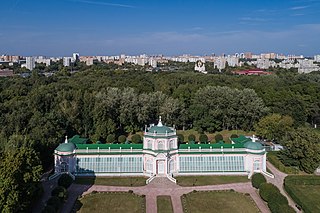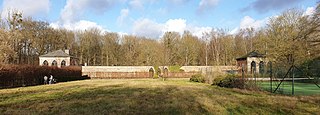
Baudouin was King of the Belgians from 17 July 1951 until his death in 1993. He was the last Belgian king to be sovereign of the Congo, before it became independent in 1960 and became the Democratic Republic of the Congo.

The Heysel Plateau or Heysel Park, usually shortened to Heysel or Heizel, is a neighbourhood, park and exhibition space in Laeken, northern Brussels, Belgium, where the Brussels International Exposition of 1935 and the 1958 Brussels World's Fair took place.

Laeken or Laken is a residential suburb in the north-western part of the Brussels-Capital Region, Belgium. It belongs to the municipality of the City of Brussels and is mostly identified by the Belgian postal code: 1020. Prior to 1921, it was a separate municipality.

An orangery or orangerie is a room or dedicated building, historically where orange and other fruit trees are protected during the winter, as a large form of greenhouse or conservatory. In the modern day an orangery could refer to either a conservatory or greenhouse built to house fruit trees, or a conservatory or greenhouse meant for another purpose.

The Royal Museum for Central Africa (RMCA), communicating under the name AfricaMuseum since 2018, is an ethnography and natural history museum situated in Tervuren in Flemish Brabant, Belgium, just outside Brussels. It was originally built to showcase King Leopold II's Congo Free State in the International Exposition of 1897.

Meise Botanic Garden, until 2014 called the National Botanic Garden of Belgium, is a botanical garden located in the grounds of Bouchout Castle in Meise, Flemish Brabant, just north of Brussels. It is one of the world's largest botanical gardens, with an extensive collection of living plants and a herbarium of about 4 million specimens. The current garden was established in 1958 after moving from central Brussels; the former site is now the Botanical Garden of Brussels.

Xavier Mellery was a Belgian symbolist painter.

The Royal Palace of Brussels is the official palace of the King and Queen of the Belgians in the centre of the nation's capital, Brussels. However, it is not used as a royal residence, as the king and his family live in the Royal Palace of Laeken in northern Brussels. The website of the Belgian Monarchy describes the function of the Royal Palace as follows:
The Royal Palace is where His Majesty the King exercises his prerogatives as Head of State, grants audiences and deals with affairs of state. Apart from the offices of the King and the Queen, the Royal Palace houses the services of the Grand Marshal of the Court, the King's Head of Cabinet, the Head of the King's Military Household and the Intendant of the King's Civil List. The Royal Palace also includes the State Rooms where large receptions are held, as well as the apartments provided for foreign Heads of State during official visits.

Laeken Cemetery in Brussels, Belgium, is the city's oldest cemetery still in function and the resting place of the Belgian royal family. It is known as the Belgian Père Lachaise, after Paris' famous cemetery, because it is the burial place of the rich and the famous and for the abundance of its funerary heritage.
The Royal Trust Society Of Belgium was a donation to the state proposed in a letter by King Leopold II of Belgium on 9 April 1900. In addition some properties were added to the donation in a letter of 15 November 1900. The Belgian government accepted the donation by law on 31 December 1903. When the King handed the Congo Free State over to the Belgian government on 28 November 1907, additional properties were added to the Royal Trust.

The Palace of Laeken or Castle of Laeken is the official residence of the King of the Belgians and the Belgian royal family. It lies in the Brussels-Capital Region, 5 km (3 mi) north of the city centre, in Laeken, and sits in a large private park called the Royal Domain of Laeken.

Alphonse Hubert François Balat was a Belgian architect.

The Church of Our Lady of Laeken is a Roman Catholic parish church in the Brussels district of Laeken, Belgium. Built in neo-Gothic style, it was originally erected in memoriam of Queen Louise-Marie, wife of King Leopold I, to the design of the architect Joseph Poelaert.

The Botanical Garden of Brussels is a former botanical garden in Brussels, Belgium. It was created in 1826 and stood on the Rue Royale/Koningsstraat in Saint-Josse-ten-Noode, near Brussels' Northern Quarter financial district, until its relocation in 1938 to the National Botanic Garden of Belgium in Meise, Flemish Brabant.

Neoclassical architecture appeared in Belgium during the period of Austrian occupation in the mid-18th century and enjoyed considerable longevity in the country, surviving through periods of French and Dutch occupation, and the birth of Independent Belgium, surviving well into the 20th century.

The Museums of the Far East is a complex of three museums in Laeken, City of Brussels, Belgium, dedicated to Oriental art and culture, specifically that of China and Japan. Consisting of the Chinese Pavilion, the Japanese Tower and the Museum of Japanese Art, it forms part of the Royal Museums of Art and History (RMAH).

The Belvédère Château is a residence of the Belgian royal family in Laeken, Brussels, which currently houses King Albert II and his wife, Queen Paola. It is near the Royal Palace of Laeken, the official residence of the King and Queen of the Belgians. Another nearby residence, the Villa Schonenberg, is home to Princess Astrid, the sister of the current king, Philippe.

Les Orangeries of Bierbais is located in Hévillers, a section of the municipality of Mont-Saint-Guibert, located in the Wallonia in the province of Walloon Brabant in Belgium.

The Pavilion of Tervuren was a summer palace for William II, constructed between 1817 and 1823. It was located in Tervuren, Belgium. After the Belgian Revolution, it was transferred to the new royal family. The former empress of Mexico, Charlotte of Belgium, lived in the palace from 1867 till it burned down in 1879. Nowadays, the ‘Palace of Colonies’ stands on its location, and is part of the Royal Museum for Central Africa.

The Monument to the Dynasty is a monument erected in Brussels, Belgium, in memory of King Leopold I, first King of the Belgians. The monument is located in Laeken Park, on the Place de la Dynastie/Vorstenhuisplein, on top of a 50-metre-high (160 ft) hill. It completes the monumental axis, which starts from the portal of the Royal Palace of Laeken, and which leads to the monument after crossing the Avenue du Parc Royal/Koninklijk Parklaan via the Avenue de la Dynastie/Vorstenhuislaan.







































